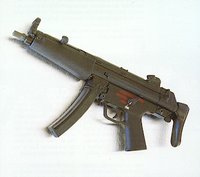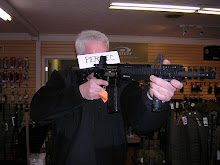Many have posited that the AK-47 series of rifles are the ultimate in MUD stoppers. While they can perform well, they are not a first choice. Obviously, the 7.62X39 round will drop the MUD if the shot is placed well. Therein lies the rub, though: the AK is not an accurate rifle. There are other choices that perform better.
The requirements of the projectile used against an MUD are different from those required to put down a human. Generally, death from gun shot occurs in humans due to loss of hydraulic pressure. This occurs through profuse bleeding. There's no significant bleeding going on with a zombie. Because the animation occurs in the brain because of the virus, blood flow no longer is an issue. This is why center mass shots are ineffective; no loss of hydraulic pressure there matters after infection. Shots to the hip area are still valid, although permanent stoppage will not be inflicted. Shots that break the pelvic bones may cause loss of mobility, but will not cause damage beyond that. Normally, shots to that region produce profuse bleeding because of the femoral arteries. Its a different situation altogether with MUD's.
Remove the head or destroy the brain. Working in the Zombie Hunter's (ZH) favor is the fact that once penetration of the skull bones has been achieved, destroying the brain with a high velocity projectile is not that difficult. Unlike muscular tissues, brain tissues do not have an elastic quality. If a bullet passes through them, kinetic energy becomes hydraulic energy, and the brain tissues become pulverised rather than blown out of the way in a temporary cavity. Muscular tissue can be repaired. Brain tissue cannot. This fact, coupled with the characteristic that blood flow or breathing disruption is no longer critical, means that as long as the round can penetrate the skull bones (assuming a frontal brain shot, because those are the hardest, thickest bones in the body) and reach the brain, it will serve to permanently disable the MUD.
That leaves the door wide open for what will stop the MUD, provided penetration and hydrostatic pressure are available. Consider what happens when a bullet enters a medium like a melon. Melons have high water content and hard outer skins. The bullets, especially rifle bullets, create massive inter-melon destruction. The same thing happens to a recently reanimated skull. The overpressure created by the rifle bullet's impact and subsequent path through the brain cause annihilative destruction. Such happy stuff to think about!
The parameters being what they are, what is needed is a rifle that is ergonomic and that has very good to excellent accuracy inherent in the design. The target is small, about the size of a 3X5 inch card. The area you're looking to be able to hit is a box that starts at about the eyebrow line and ends at the upper lip. Hitting that box will put the lights out permanently. Now the question becomes which tool is right to make that hit.
In general, there are many, many appropriate rifles and sub machine guns that will do the job. In order to make the hits count, accurate rifles are a must. There are some considerations to point out, which have an impact on the end user's choice.
Large caliber sub guns, like the .40 Short and Wide, .45 ACP, and 10mm guns from HK are awesome weapons. They have relatively large magazines, and have tremendous accuracy as a matter of design. They're short, handy, and fast to employ. The drawback is that the overall range is limited. A pistol-caliber subgun, unless in the hands of a master class shooter, is a 100 yard or less weapon.



HK UMP HK MP5 HK MP5/10mm
In order to increase reach, a round with better ballistics and more downrange retained velocity is needed. Several rifles fit into this bill, and the assault rifle is in its element here. Chambered in 5.56X45, 6.8 SPC, 5.56X39, or a similar round are Zombie Slayers. In order to take advantage of the rifle's greater long range accuracy, rifle length barrels shouldn't be overlooked in the SPR (Special Purpose Rifle) role. Barrels between 16 and 20 inches have increased velocity and better terminal ballistics at distance than does the 14.5 inch or shorter carbine, such as Colt's M4 . While the shorter barrels are handier in vehicles and in confined spaces, a higher price is exacted for their use, to include increased muzzle blast and temperamental operation.


Rifle length AR from Daniel Defense
10.5" full auto carbine
Of course, rifles like the AK variants and the SKS can be used in a pinch, and more exotic weaponry can be employed, but they have major drawbacks compared to the AR variants. Their lack of accuracy is a detriment at distance. Since head shots are a must, an accurate rifle is the difference between life and death...or undeath, as the case may be. The AR system is both accurate and easy to maintain, which makes it a prime candidate for this application. Easy availability of spare parts, magazines, and ammunition are all factors that must be considered when developing the ZOS kitlist. This puts the AR at the head of the pack. In addition, the 5.56X45 ammunition is much lighter and physically smaller than the 7.62X39 that the AK uses. a 30 round AR magazine is considerably smaller and lighter than its steel AK counterpart, which means you can carry more ammunition in a smaller area, and that the ZF (Zombie Fighter) can be lighter and more maneuverable.
Many people still hold to the erroneous idea that "the AR weapon system is inherently unreliable." After 30+ years of development, that simply isn't the case anymore. In addition, the AR platform has been recently updated with the introduction of reasonably priced piston driven uppers, such as those produced by Patriot Ordnance Factory. Excellent reliability has been updated with fantastic reliability and cooler operation. In terms of absolute reliability and easy maintenance, piston driven weapons are king.
There is another layer of defense that is covered by the large-caliber battle rifles. These are magazine fed, semi automatic rifles that generally fire the 7.62X51 (.308 Winchester) round. Magazine capacity is typically 20 rounds because of the size of both the ammunition and the magazine itself. It is also heavier than assault rifle ammunition is. While the .30 caliber round adds additional reach for longer range shots, a price must be paid in terms of carrying less ammunition, and having that load be heavier. If available, the ZF squad should appoint a DM (Designated Marksman) to use a 7.62 rifle for stopping a Zombie advance outside the envelope in which the 5.56 or 6.8 rifles are effective.
DMR's are typically semi automatic rifles, like the Knight's Armament Co SR-25 or AR-10 rifles from Armalite. In a pinch, and outside of the military application of this information, a bolt action rifle may be used. Another advantage of pressing a precision rifle or hunting rifle into this role is that even heavier rounds may be used. Because of the greater terminal ballistics at longer range, many militaries around the world are transitioning from the 7.62X51 to a variation of the .300 or .338 Magnum rounds. The advantage is very long range shooting ability. The drawback is that the weapon is far slower to reload and has a far smaller magazine capacity; typically three or four rounds. As a tool in the toolbox, they are a nice addition. If they're going to be the primary weapon, great care must be taken as to when to employ the rifle and from what position. While the rifle has great range, it also has substantial muzzle blast, and that much noise can draw other MUD to your position if the rifle is employed carelessly.
If given the choice, the ZDO (Zombie Defense Organization) that is operating in the affected area should arrange their weaponry so as to take advantage of different envelopes of engagement. Starting with the precision marksman's rifle, to the long range DMR, then to the middle range assault rifle or carbine, and finally to the sub machine gun for CQB or other close range encounters.
Care must be taken in selecting which weapon system will be used in a ZD situation. While encounters are not likely to be exceptionally long engagements, it is possible that a siege-type situation may be encountered. Balancing the lethality of the weapon against its portability and the capacity to carry large amounts of ammunition is a must. Now is the time to consider and decide these issues, before you find yourself trying to defend a home with copious amounts of windows with a small magazine, bolt action hunting rifle. Better than nothing, but perhaps considering saving one last round may be in order.




No comments:
Post a Comment